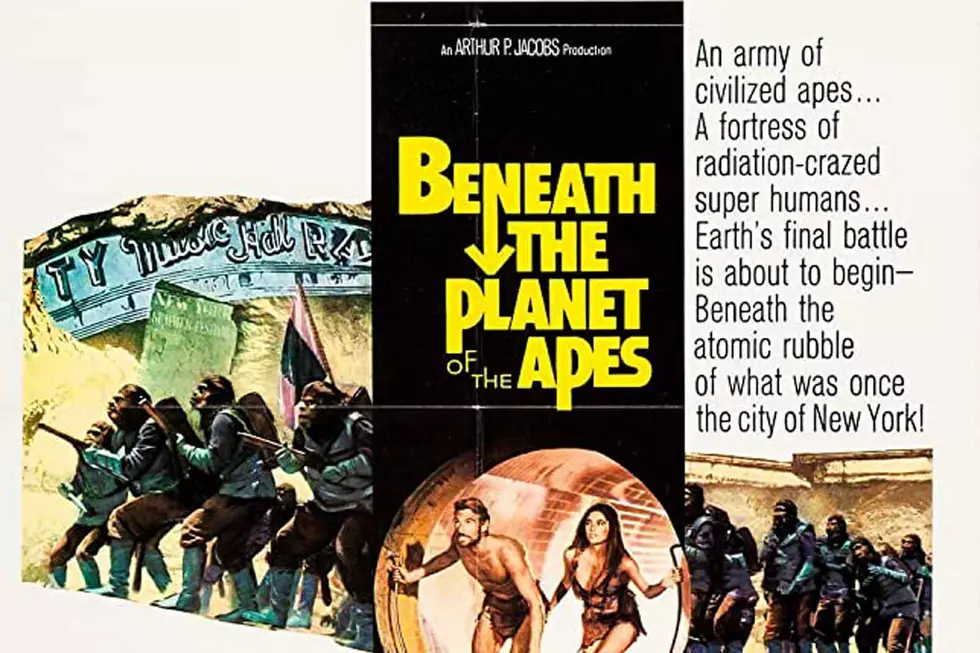
50 Years Ago: ‘Beneath the Planet of the Apes’ Goes Underground
The ending of 1968's Planet of the Apes really didn't necessitate a sequel. After all, when you reveal one of the best and most despondent finishes ever captured on film – the out-of-time astronaut was actually on Earth! – there's not much else to say.
At least that's what the original novel's writer, Pierre Boulle, intended. The filmmakers behind the first movie thought that too. But then Planet of the Apes became a huge hit, and Hollywood got other ideas.
So, a new plot was devised, a new star was cast to replace Charlton Heston (who agreed to a small appearance in the sequel) and a surreal new layer was added to the nuclear apocalypse that sent mankind scrambling for survival in a world ruled by apes.
Beneath the Planet of the Apes arrived on May 26, 1970, and marked the first of four increasingly sillier sequels. Ted Post – whose feature debut, the 1968 Clint Eastwood revenge western Hang 'Em High, came after nearly two decades in television – was tapped to direct from a script by producer Mort Abrahams and Paul Dehn, who had a hand in Goldfinger's screenplay. (Both Boulle and Rod Serling, who wrote the screenplay for the 1968 film, were first approached to pen the sequel, but their scripts were rejected.)
And from the start, Beneath the Planet of the Apes spirals into a bizarre hybrid of science-fiction whimsy and the fantasy world the franchise was creating for itself. The movie literally begins where the original left off two years earlier, with distraught astronaut Taylor (Heston) and his mute companion Nova continuing their horseback journey to the Forbidden Zone.
After fire inexplicably shoots up from the ground, the earth opens up. While checking all this out, Taylor approaches a cliff and, even more inexplicably, disappears into it. The flames, opened earth and mysterious wall all disappear too, leaving Nova alone. But not for long.
Another astronaut, Brent (played by James Franciscus), who was sent to investigate the missing crew of the first movie, crashes his spaceship pretty damn close to where Taylor and Nova were walking. As luck would have it, Brent finds Nova, who's wearing Taylor's dog tags, and leads her back to Ape City to look for his missing pal.
Watch the Trailer for 'Beneath the Planet of the Apes'
Over the course of 95 minutes, Brent meets friendly chimps (Cornelius and Zira, returning from the first film), not-so-friendly gorillas (led by new character General Ursus) and the inquisitive but arrogant orangutan Dr. Zaius (also from the first movie). He's also reunited with Taylor. In the movie's most out-there development, and where it gets its title, he runs into a group of subterranean mutants that happened to have telepathic powers.
Oh, and they also have a nuclear bomb, which they worship as a god.
Every single one of these elements collides in the film's climax: the apes, the astronauts, the mutants and, most significantly, the bomb – which spins into motion the next movie in the series, 1971's Escape From the Planet of the Apes. (From there, the franchise launched, within the next few years, two more movies, a TV show, an animated series, comic books and pretty much anything else you could slap a monkey on.)
There's a lot to take in with Beneath the Planet of the Apes. It is, by turns, the goofiest and best of the sequels; it's also the most incredulous, which is saying a lot about a movie series centered on talking apes that eventually got around to an entry that basically doubled as a treatise on contemporary race riots.
It's the most curious outing too. The apes are almost secondary to the plot – essentially relegated to the same roles they had in the first movie – as the mutants grab center screen once they're introduced. Living in the ruins of the New York City Subway system, they wear masks to disguise their deformed appearance caused by radiation, telepathically command Brent and Taylor to fight each other and hold a bizarre ceremony in honor of their still-active "doomsday bomb" deity.
Still, the most perplexing part about Beneath the Planet of the Apes is its mere existence. The first movie pretty much got it right. That's why Heston didn't want to return (he agreed to his brief supporting role on the condition that he die in the movie and his pay went to charity), Post didn't want to direct until the screenplay addressed a number of his concerns (the first film's director, Franklin J. Schaffner, was busy making Patton) and critics were skeptical as to how the desolate tone of Planet of the Apes' ending could even be followed, all things considered. (This is also the only Apes project in the '70s, besides the animated series, that Roddy McDowall didn't participate in; he was filming another movie at the time.)
None of this really mattered. The movie was a hit and a sequel was already in producers' minds by the time Beneath the Planet of the Apes wrapped production, even though – just like with the first film – a downer of an ending didn't appear to leave much room to roam. Yet, Escape From the Planet of the Apes somehow found a glimmer of hope amid all the hopelessness, adding even more confusion to the growing franchise's back-to-the-future philosophy.





